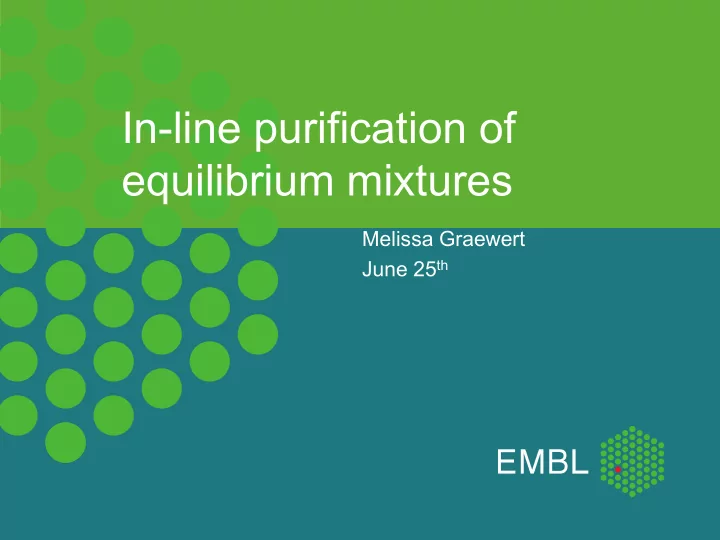

In-line purification of equilibrium mixtures Melissa Graewert June 25 th
The odd one out
Polydisperse samples • Aggregates • intrinsic property of the sample • eg. monomer-dimer-oligomer equilibrium • or incomplete formation of complexes
Sample Characterization nativeMS Analytical ultracentrifugation percentage m/z) Native Gel Size Exclusion Dynamic Light Static Light Electrophoresis Chromatography Scattering Scattering PREPARING THE EXPERIMENT
o Size Exclusion Chromatography
J. Synchrotron Rad. (2004)
Information extracted from the elution profile of an initially polydisperse solution of commercial BSA. Column: SHODEX 402.5- 4F. Flow rate: 150 µl min −1 . Injected volume: 5 µl at 88.8 g l −1 . ( a ) Chromatogram of the elution profile. The complex profile indicates the presence of several species. The main peak, at 17.04 min, corresponds to BSA monomer. 25/06/2016 8
The SAXS instrument at the Barkla Laboratory of Biophysics. The set-up includes a Dectris PILATUS 300K-20Hz detector, three pin- hole optics and Rigaku FR-E+ Superbright X- ray generator.
SEC – SAXS but some disadvantages: Analysis of thousands successive scattering curves a posteriori No knowledge of the solute concentration Uncertainity about equilibrium driven systems further characterisation useful for automation and validation Add MALVERN BOX RI concentration, automation RALS MW UV concentration (when dn/dc not known (lipids, DNA, etc.))
M.O.S.E.S. (Microsplitting for Online Separation, Extended characterization and SAXS analysis)
M.O.S.E.S. (Microsplitting for Online Separation, Extended characterization and SAXS analysis)
M.O.S.E.S. (Microsplitting for Online Separation, Extended characterization and SAXS analysis)
M.O.S.E.S. (Microsplitting for Online Separation, Extended characterization and SAXS analysis)
M.O.S.E.S. (Microsplitting for Online Separation, Extended characterization and SAXS analysis)
Light absorbance: ~ c, ε
Light absorbance: ~ c, ε Refraction: ~ c, dn/dc dual cell, deflection design
Light absorbance: ~ c, ε Refraction: ~ c, dn/dc dual cell, deflection design
Light absorbance: ~ c, ε Scattering: ~ c, dn/dc, MW Refraction: ~ c, dn/dc
M.O.S.E.S. (Microsplitting for Online Separation, Extended characterization and SAXS analysis) Independent Molecular Weight determination Concentration of single frames (Scaleing, MW) Automation
M.O.S.E.S. (Microsplitting for Online Separation, Extended characterization and SAXS analysis)
M.O.S.E.S. (Microsplitting for Online Separation, Extended characterization and SAXS analysis)
Automated M.O.S.E.S. Step 1: identification of buffer region (RI signal)
Automated M.O.S.E.S. Step 1: identification of buffer region (RI signal) Step 2: Buffer subtraction, I(0) and RG determination of each curve
Automated M.O.S.E.S. Step 1: identification of buffer region (RI signal) Step 2: Buffer subtraction, I(0) and RG determination of each curve Step 3: Correlation of the SAXS data with MALVERN data Step 4: Extraction of biophysical information for each frame
Automated M.O.S.E.S. Step 1: identification of buffer region (RI signal) Step 2: Buffer subtraction, I(0) and RG determination of each frame Step 3: Correlation of the SAXS data with MALVERN data Step 4: Extraction of biophysical information for each frame
Automated M.O.S.E.S. Step 1: identification of buffer region (RI signal) Step 2: Buffer subtraction, I(0) and RG determination of each frame Step 3: Correlation of the SAXS data with MALVERN data Step 4: Extraction of biophysical information for each frame Step 5: Determination of “peak region”, scaling and averaging of respective curves Step 6: Handing over of final curve to down-stream analysis MW MW MW MW MW I(0) expected SLS Porod Modell 45 kD 48 kD 50 kD 46 kD 39 kD
Automated M.O.S.E.S.
M.O.S.E.S. (Microsplitting for Online Separation, Extended characterization and SAXS analysis) Phospholipase B of Legionella pneumophila (Lpn PlaB) Kuhle et al.; J Biol Chem. 2014 Jul Gräwert et al.; Scientific Reports online June 2015
M.O.S.E.S. (Microsplitting for Online Separation, Extended characterization and SAXS analysis)
M.O.S.E.S. (Microsplitting for Online Separation, Extended characterization and SAXS analysis) — PlaB (batch, 4.5mg/ml) — PlaB, tetrameric peak lg I(q), a.u. q, nm -1
M.O.S.E.S. (Microsplitting for Online Separation, Extended characterization and SAXS analysis) — PlaB (batch, 4.5mg/ml) — PlaB, tetrameric peak lg I(q), a.u. q, nm -1
MW RALS = 230 ± 15 kD — PlaB (batch, 4.5mg/ml) lg I(q), a.u. — PlaB, tetrameric peak MW I (0 ) = 225 ± 15 kD MW Vol = 170 ± 30 kD MW DAMMIF = 203 ± 30 kD MW SEC ~ 100 kD q, nm -1
MW RALS = 230 ± 15 kD — PlaB (batch, 4.5mg/ml) lg I(q), a.u. — PlaB, tetrameric peak MW I (0 ) = 225 ± 15 kD MW Vol = 170 ± 30 kD MW DAMMIF = 203 ± 30 kD MW SEC ~ 100 kD q, nm -1
MW RALS = 230 ± 15 kD — PlaB (batch, 4.5mg/ml) lg I(q), a.u. — PlaB, tetrameric peak MW I (0 ) = 225 ± 15 kD MW Vol = 170 ± 30 kD MW DAMMIF = 203 ± 30 kD MW SEC ~ 100 kD q, nm -1
MW RALS = 230 ± 15 kD — PlaB (batch, 4.5mg/ml) lg I(q), a.u. — PlaB, tetrameric peak --- PlaB, dimeric peak MW I (0 ) = 225 ± 15 kD MW Vol = 170 ± 30 kD MW DAMMIF = 203 ± 30 kD MW SEC ~ 100 kD q, nm -1
Simultaneous Data Collection
M.O.S.E.S. (Microsplitting for Online Separation, Extended characterization and SAXS analysis) host Lipolytic active pathogen monomeric PlaB Activation Via dimeric state Electron micrograph of Legionella Self protection pneumophila wwww.wikimedia.org through inactive tetrameric PlaB
M.O.S.E.S. (Microsplitting for Online Separation, Extended characterization and SAXS analysis) • Alternative strategy to study (moderatly) polydisperse samples • Required sample amounts: at least 50 ul of > 5mg/ml • Sufficient buffer • Optimize your SEC run • If possible collect batch sample as well • Check for radiation damage, add 3% glycerol (if feasible)
M.O.S.E.S. 2.0 HPLC pumps Autosampler Even more automation
Sample Characterization nativeMS Analytical ultracentrifugation percentage m/z) Native Gel Size Exclusion Dynamic Light Static Light Electrophoresis Chromatography Scattering Scattering PREPARING THE EXPERIMENT
Katja Kuhle Antje Flieger Special Thanks!!! Robert Koch Institute THE SAXS GROUP
Recommend
More recommend